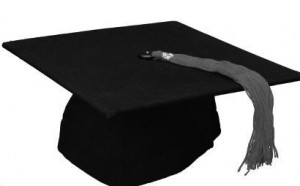 Much of the editorial in JBHE deals with the progress of Black students at the nation’s highest-ranked colleges and universities. But it is always important to keep in mind that large state-operated universities enroll as much as 75 percent of all African-Americans who are participating in higher education in this country. Tens of thousands of Black students are enrolled at the nation’s flagship state universities, generally the premier public institutions in a given state.
Much of the editorial in JBHE deals with the progress of Black students at the nation’s highest-ranked colleges and universities. But it is always important to keep in mind that large state-operated universities enroll as much as 75 percent of all African-Americans who are participating in higher education in this country. Tens of thousands of Black students are enrolled at the nation’s flagship state universities, generally the premier public institutions in a given state.
Every year since JBHE has tracked graduation rates for Black students, the University of Virginia has had the highest graduation rate for African Americans. This year is no exception. The Black student graduation rate of 85 percent at the University of Virginia is the highest of any of the nation’s flagship state universities. The University of North Carolina at Chapel Hill is second, with a Black student graduation rate of 76 percent. The University of Georgia has a Black student graduation rate of 75 percent. This is up from 66 percent just four years ago. Other flagship state universities with a Black student graduation rate at or above 70 percent are the University of Florida, the University of Washington, the University of Michigan, Penn State, and the University of California at Berkeley. All told, there are eight flagship state universities with Black student graduation rates above 70 percent, double the number from four years ago.
It is also useful to note the racial gap in graduation rates at flagship state universities. At the University of Hawaii, the Black student graduation rate is a low 42 percent. But is actually higher than the rate for White students. At all other 49 flagship state universities, White students graduate at a rate higher than Black students.
At the University of South Carolina, the Black student graduation rate of 65 percent is only two percentage points below the rate for White students. At the University of Georgia, the racial gap is five percentage points. At 38 flagship state universities, the racial gap in graduation rates is more than 10 percentage points.
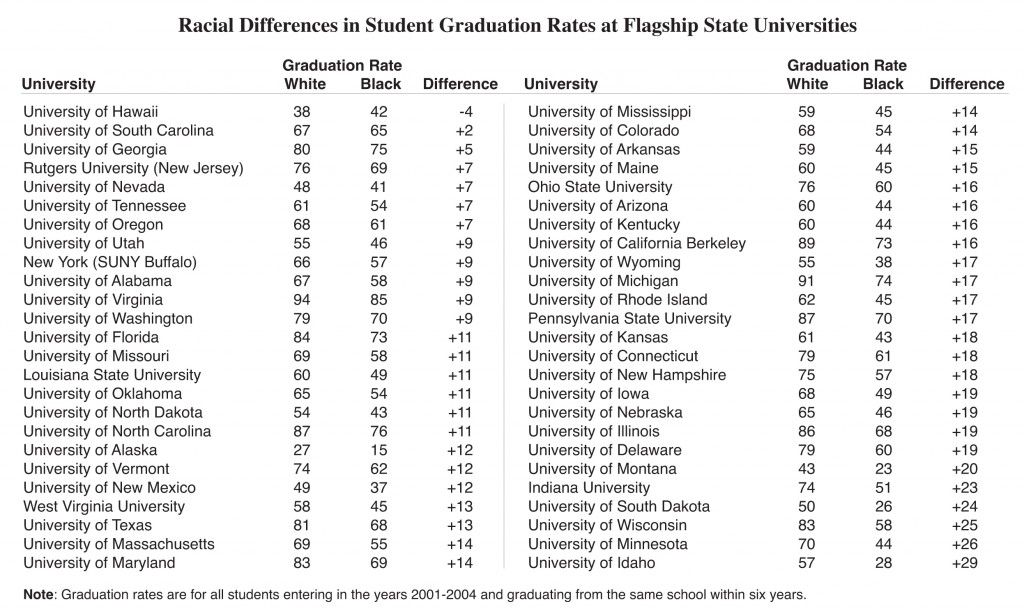
The largest racial gap is at the University of Idaho. There, the Black student graduation rate of 28 percent is 29 percentage points below the rate for White students. Since very few Black students are enrolled in higher education in Idaho, more significant are the large racial gaps in graduation rates at flagship state universities in Illinois, Wisconsin, Indiana, Delaware, Ohio, Connecticut, Michigan, Kentucky, Pennsylvania and California, all state universities with large numbers of Black students. The flagship universities in these states all have a racial gap in graduation rates of more than 15 percentage points.

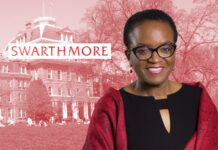
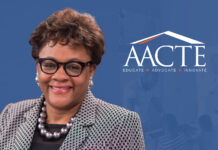


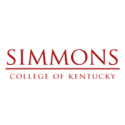





The University of Virginia has the highest BLACK graduation rate for both public and private Universities for the following reasons:
1. Virginia only admits and selects very high potential students in which many could be admitted to any of the Ivy’s. The University of Virginia is a Ivy League type public University in the South.
Many of the Black Uva students choose Virginia over the much colder climate schools in the north such as Penn, Columbia, Brown, Yale, Dartmouth, Harvard and Princeton. The in-state UVa students have found the racial atmosphere in Charlottesville Virginia more favorable than in New Haven Connecticut, Cambridge Massachusetts, Philadelphia Pennsylvania, Providence Rhode Island, Princeton New Jersey, New York City, and Hanover New Hampshire. Charlottesville is the idea place to study for the serious minded student.
2. The University of Virginia has the best nationally acclaimed and recognized academic support systems and Peer Advisory Programs in the United States of America.
a. The University of Virginia has hired and promoted some of the most talented totally committed faculty and staff of African Americans, Euro-Americans, Asian Americans and Hispanic Ameircans in the country.
3. The University of Virginia has an active outstanding Parent Advisory Support system/team throughout the state of Virginia, and the USA.
The African American parents are heavily involved at every level in said UVa to make sure their child succeeds and all African Americans students excel at said institution.
4. The vast majority of African American students admitted or selected for Uva, parents and grandparents are college graduates. In some cases their great great grandparents also graduated from college. Many of these parents graduated from HBCU’s.
Since 1998, I have been thoroughly impressed with the graduation rates of Black students at the University of Virginia for cohort year after cohort year. And since then, I have always dreamed of visiting this institution to learn, firsthand, about the strategies that are employed to achieve such outstanding educational outcomes.
I might mention that my intent was to quote publicly that “The University of Virginia has the highest BLACK graduation rate for both public and private Universities”. But someone(s) would likely say, even better than the Ivy League schools? What about schools such as Duke, Stanford, Rice, Northwestern, Notre Dame, Washington U., and Rice? So, I went to the NCAA web site (under the heading, Federal Graduation Rates) which reports data for the same cohort years mentioned in the JBHE article. Here is what I found from a non-exhaustive search:
– One public institution, College of William and Mary, graduated the aggregate Black cohort at a rate of 88%.
-Seven of the Ivy League schools graduated Black students at rates higher than 85%(the graduation rate for Black students at Columbia was 85%).
– The graduation rates for Black students at Bryn Mawr, Bucknell, College of the Holy Cross, Davidson, Duke, Notre Dame , Northwestern, Rice, Swarthmore, Vassar, and Wellesley were higher than 85%.
Thus, I believe I can safely say that based on the data found on the NCAA web site, the Black graduation rate at Virginia was higher than all but one public institution and most private institutions. I might add that my impression of this great institution is no way dampened by these findings. It is a model for all higher education to follow.
Emile Pitre: Your response to the JBHE article titled Black Progress In Graduation Rates at Flagship State Universities dated Dec.2, 2011 were many, positive, and noteworthy in that they were, I believe , not only well-meaning and well informed but courageous, non politically motivated, nor orchestrated by the status quo.
In my communication, fact and statement of fact should remain paramount while subjectivity may remain or to be relegated to a position of secondary consideration.
While pedestrian in nature, Mr. Pitre it appears as though you set out on a mission to disprove and invalidate the above JBHE article in question for whatever motivation.
If your intent was to “quote publicly that the University of Virginia has the highest Black graduation rate for both public and private Universities why didn’t you site multiple sources with correct dates to corroborate your information that you found?
You failed to mention the fact that the JBHE has been tracking the graduation rates as flagship state universities since 1996 ,and the University of Virginia has come in first place since the JBHE began tracking said.
You have based your whole argument on the NCAA web site report under the heading Federal graduation rates, which you state said College William & Mary has a Black graduation rate of 88%. You fail to mention the date of the NCAA Report or the year that said College of William Mary had a Black Graduation rate of 88%. Therefore Mr. Pitre your entire information is based upon flawed data. The College of William & Mary may have obtained that 88% Black graduation rate in 1995 or 2005 therefore you entire analysis is incomplete.
Mr Pitre, you win arguments with facts and corroborated information not with some obscure report from the NCAA without said date for said time period.
What the JBHE found out since they have been tracking the Black graduation rates at Flagship state schools is that the University of Virginia has had the largest Black Graduation rate, and you have presented nothing to counter or refute that claim.
Also note Mr. Pitre that the University of Virginia has admitted more Black students than the College of William & Mary ever since the JBHE began tracking said Black Graduation rates.
You may obtain that information by contacting said schools or making a formal request to the Federal Dept. of Education.
Further the University of Virginia has admitted more Black students than Rice, Stanford, Duke, Northwestern, Washington U., Holy Cross, Notre Dame, Swarthmore, Vassar, and Wellesley in the subject years.
The SAT’s scores for incoming Black Fros. at the University of Virginia are higher than the scores of incoming Freshemen at the College of William& Mary and UC Berkeley. Source, U.S. News & World Report 2011 Edition, America’s Best Colleges.
I know of one student who was admitted to Dartmouth, but she chose Uva instead because of the excellent support system and high achieving Black students. I know another UVa grad who was admitted to Brown, and Princeton, but she also chose UVa for the excellent support system for Black students, and great role models.
Note Mr. Pitre, the University of Virginia Black Law School students have beat Harvard Black Law School everytime in the annual Thurgood Marshall Moot Court Competition.
Who did you meet with when you visited the University of Virginia?
Mr. Pitre may I suggest that the next time you attempt to do a project make sure you do the necessary through detailed research to support the position.
The latest four-year average graduation rate for Black students at the College of William and Mary is 88 percent. The rate at the University of Virginia for the same period is 85 percent.
This article was concerned only with “flagship” state universities and not all state-operated institutions. In the flagship category, the University of Virginia remains the top achiever and has held that position since JBHE began to track this data.
But the important fact is that both of these high quality educational institutions are doing a great job in graduating their Black students.
Correction from the above post to Mr. Pitre: Mr. Pitre, I highly suggest that the next time you attempt to do a project on any topic or subject that you make sure that you do all the necessary thorough in-depth detailed research to support your position.
Note: Mr. Pitre the University of Virginia Black Law School students, have beaten the Black law school students from Harvard Law School in very year that the Thurgood Marshall Moot Court Competition was held.
Mr. Pitre who did you meet with at the University of Virginia? Could you kindly give us a detailed account of your interviews with the faculty/staff at the University of Virginia.
Did you meet with Dean Sylvia Terry, who was in charge of the nationally acclaimed Peer Advisory Program at UVa for well over twenty years?
*In 1998 JBHE Reports revealed that the University of Virginia had a 89% graduation rate for Black students.
* The goal of the University of Virginia is to have a 100% graduation rate for Black students, and all UVa students who desire to matriculate to Mr. Jefferson’s Academic Village.
Good luck with your future endeavors!
I appreciate the input provided by Mr. Saunders. I regret that it was construed as an attempt to disprove and invalidate what was reported in the JBHE article. I am well aware of how long JBHE has been tracking Black graduation rates at both flagship state universities, as well as other universities. I have the utmost respect for this publication.
In regard to the period the College of William and Mary obtained a graduation rate of 88%, it was for the same period cited in the JBHE article, i.e., 2001-2004 cohorts who graduated from the same school within six years. I might also add that I understand that the College of William and Mary is not a flagship university, but the US News & World Report 2011 Edition does designate it as a public university.
Mr. Saunders, you asked with whom did I meet at the University of Virginia. My response is that I never met with anyone. What I stated was that I always dreamed of visiting this institution. That has NOT happened as of this date.
In terms of the number of Black students admitted by UVA relative to the numbers admitted at the institutions referred to in my comments, I do not dispute the fact that the 2001-2004 cohort size at UVA was, for example, almost twice the size of the cohort entering Duke and almost four time the size of the cohort entering College of William and Mary. Thus, it is clear that UVA’s efforts are more impactful.
With regard to the data source that I used, I might add that it is routinely cited by U.S. News & World Report 2011 Edition and earlier editions and, for example by Bok and Bowen, authors of their widely acclaimed book “The Shape the Shape of the River”. And, if I am not mistaken, JBHE has cited this source in the past as well.
In closing, I would like to again thank Mr. Saunders for his feedback and well wishes.
Mr. Pitre: The 2009 Edition, U.S.News & World,Report Ameica’s Best Colleges list the College of William Mary as a public university on page 93.
Further they list the following schools as the top public universities in the USA, which are as follows:
The Top 50 Public National Universites:
1. Univ. of California-Berkeley
2. University of Virgnia
3. U. of California-Los Angeles
4. U. of Michigan-Ann Arbor
5. U. of N.C.-Chapel Hill
6. College of William and Mary (VA)
US News&World Report does in fact list said William and Mary as a bona-fide Public institution on page 93 in said report. Mr. Pitre perhaps you just simply overlooked this important fact.
The College of William and Mary has been a public institution since its founding in 1693.
In closing, Mr. Pitre I wish you the best of luck in your future endeavors.
Mr. Saunders,
I beg to differ that I overlooked the fact that the College of William and Mary is a public institution.The last line of the second paragraph of my comments dated January 8, 2012 states exactly that.
Perhaps it was unclear because it was embedded in my response to the JBHE editor’s comment that the article was only concerned with “flagship” state universities and the word state was omitted (see inserted word).
“I might also add that I understand that the College of William and Mary is not a flagship [state] university, but the US News & World Report 2011 Edition does designate it as a public university”.
Mr. Pitre: I was very well pleased to see that you finally understand that the College William & Mary is a public institution.
Yes, the College of William & Mary also does a good job of educating all of its students.
The University of Virginia doesn’t take a back seat to any school in the country relative to the quality of its entire academic programs or its student body.
* Just recently Mr. Pitre, eight University of Virginia professors are among the 121 most influential education scholars in 2012, in a national ranking complied by Education Week columnist Rick Hess.
U.Va placed the third-highest number of professors on the list, behind Stanford University (14) and Harvard (13).
Note: Mr. Pitre Stanford and Harvard are private institutions.
U.Va Curry School of Education, Dean Robert Planta led the U.Va contingent, ranked 19th-most influential education scholar in the NATION.
Having an outstanding faculty/staff is one of the main reason’s why U.Va has such a consistent high graduation rate for Black students and all of its students.
* Note the top rate scholar was Stanford’s Linda Darling Hammond.
Mr. Pitre, you may elect to visit the great state of Virginia, and I suggest that you go to the following places and sites:
I. Jamestown Settlement, Jamestown Virginia
2. Colonial Williamsburg, Williamsburg Virginia.
A. Carter Plantation.
B. Powhattan Plantation
3. The College of William and Mary in Williamsburg Va.
4. The Pawmunkey Indian Museum, King William Va.
5. Wolf Creek Indian Village, Bastian, Va.
6. Yorktown, Virginia. I am quite sure that you are aware of the fact that Yorktown, Virginia was the site of the last battle in America’s War of Independence from the British Crown.
7 Appomattox Virgina, the town in Central Virginia where Lee surrendered to Grant on April,9, 1865, ending the Civil War. Note many Rebel troops did in fact still fight after Lee’s surrender throughout the South.
8. Luray Caverns, in Luray Virginia
9. Southampton, Virginia. Site of Nat Turner’s enslaved revolt.
10. Richmond Virginia, site of the famous Civil War bettle and capital of the Confederate States of America.
11. Visit the University of Virginia in Charlottesville, Virginia.
12. Mulatto Run Bridge/Creek in Madison County Virginia
13. More Civil War battles were fought in Virgina than any other state so you can have a few field days visiting the many sites.
14. Tour the naval yards in Newport News, Norfolk and Tidewater, Virginia
15. Harper’s Ferry Virginia, which is now Harper’s Ferry West Virginia. You must visit the site of John Brown’s raid and take a tour with a bona-fide U.S. Park Ranger of said site. This is a must for all students.
16. Fort Monroe Virginia, has a great deal of history on the struggles of enslaved Africans, and some scholars believe that Fort Monroe played a pivotal part in the beginning of the war between the states.
17. King’s Dominion.
When you visit all of the above I have 19 more sites that you might want to visit in the state of Virginia.
Mr. Saunders,
Your breadth and wealth of knowledge are very impressive. Thank you for sharing the must-see sites with me.
All the best,
Emile